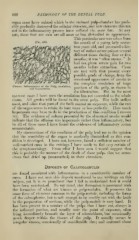Page 850 - My FlipBook
P. 850
860 PATHOLOGY OF THE DENTAL PULP.
organ must have existed which in the enclosed pulp-chamber has prob-
ably gradually destroyed the cellular elements, and new elements thrown
out in the inflammatory process have suffered the same fate. At any
rate, those that are seen are all more or less shrivelled in appearance.
This particular case was taken from
Fig. 455. the mouth of a young lady seven-
teen years old, and presented a his-
tory of rather severe pain at several
different times during four or five
months; it was "often uneasy." It
had not given severe pain for two
months before extraction. Cases
are met with that present every
possible grade of change, from the
occasional appearance of areolee to
the complete areolation of large
Chronic Inflamniation of the Pulp, areolation portions of the pulp, as shown in
and desreneratiun.
the illustration. But in the most
extreme cases I have seen the areolation has not extended to the whole
tissue. All grades wdll be found in the same pulp. The bulb suffers
most, and often that part of the bulb nearest an exposure, while the rest
of the organ seems to retain its tone more or less perfectly. How much
hypersemia may have to do in the production of this condition I cannot
say. The evidence of oedema presented by the abnormal areolae would
indicate that the effusion was hypersemic rather than inflammatory, but
in all of these cases I have found the evidences of inflammatory action
unmistakable.
My observations of this condition of the pulp lead me to the opinion
that the sensibility of the organ is markedly diminished as this con-
dition is developed. I have not, however, found a sufficient number of
well-marked cases in the cuttings I have made to feel very certain of
the symptomatology. From what I have seen I would suggest that
this is probably the manner of the death of those pulps that we some-
times find dried up (mummified) in their chambers.
Deposits of Calcoglobulin
are found associated with inflammation in a considerable number of
cases. I have not seen this deposit mentioned in any writings on this
subject, yet it is so prominent that I fail to understand how it could
have been overlooked. To my mind, this formation is associated with
the formation of what are known as pulp-nodules. It possesses the
same form of elements common to the pulp-nodule, including the forms
of the calcospherite, but is soft enough to be readily cut with the knife
in the preparation of sections, while the pulp-nodule is very hard. It
has been present in a number of the pulps th.it I have cut, always in
the inflamed portion, and usually near the point of exposure, often
Iving immediately beneath the layer of odontoblasts, but occasionally
much deeper within the tissues of the pulp. It usually occurs in
irregular masses, occasionally of considerable size; and scattered about


